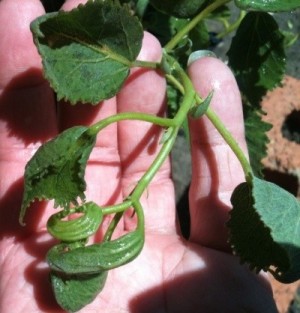Last year I was having trouble with the leaves on my hibiscus cupping very badly. Also with a Black-eyed Susan, the leaves weren't cupped, but deformed and scarred. I came to the conclusion that they had powdery mildew; all symptoms seemed to point in that direction.
This year they both came up looking perfectly fine and healthy. They were growing as they should. Then they started to look a little tattered as time passed. Of course I gave them a good shot of soapy water and fed them. I staked the hibiscus for support against the wind. They just slowly started looking worse.
I think I was incorrect in my diagnosis of powdery mildew last year. We get a lot of wind here for several days in a row at times (20 to 30 mph gusts and 15 to 20 sustained). There is nothing on this side of the house for a wind break. I placed some bricks, with 3 holes in them, a little way in front of the flower beds that were the worst target for the wind. In just 1 week the Black-eyed Susan was showing a great deal of improvement. Now it is sporting several buds. The hibiscus plants however are more toward the back of the bed and are too tall for these small bricks to make a much of a deflection against the wind. The hibiscus looks just as they did last year, there is very pronounced cupping of the leaves (most especially the newer leaves).
I am going to move them to a new location where maybe they'll be somewhat protected from the harsh winds. It is, however, in a partly shaded area. Can plants actually get mildew in an area where there is rarely any humidity or rain? We live in zone 5 in the very southeast corner of Colorado, the very southwest corner of Kansas, and just north of the Oklahoma panhandle.
We are now in the process of planting as many lilac bushes as we can around the property for a windbreak. I planted an assortment of 9 shrubs last year for this very purpose. Not nearly enough to cover the area we need covered in the country. I don't have the time to wait for those 9 shrubs to grow into a windbreak. They were planted in well thought out places, with the intent to fill in the gaps by adding a few new shrubs every year.
So, I guess the question is, what kind of wind can a hibiscus tolerate and what would the damage to the plant entail? I could be wrong again about the wind, too. The plants leaves are cupped and they just look altogether fatigued.
By LorindaWalshCO from Walsh, CO
Add your voice! Click below to answer. ThriftyFun is powered by your wisdom!
I wasn't able to load a picture of my poor hibiscus plants when I sent my question .... I am going to try now & hope it works.

I am having the same problem and I read that stress on the plant or too much nitrogen can be the cause. I did use a different type of fertilizer this year so who knows.
My hardy hibiscus has done this cupping for the first time this year. I read where someone said that excess rain could produce excess nitrogen and hurt the plants, which we had an extreme abundance of ran almost every day this spring. Someone else said broad mites. I do have the hibiscus planted next to some purple bee balm which is notorious for getting powdery mildew though.
Add your voice! Click below to answer. ThriftyFun is powered by your wisdom!